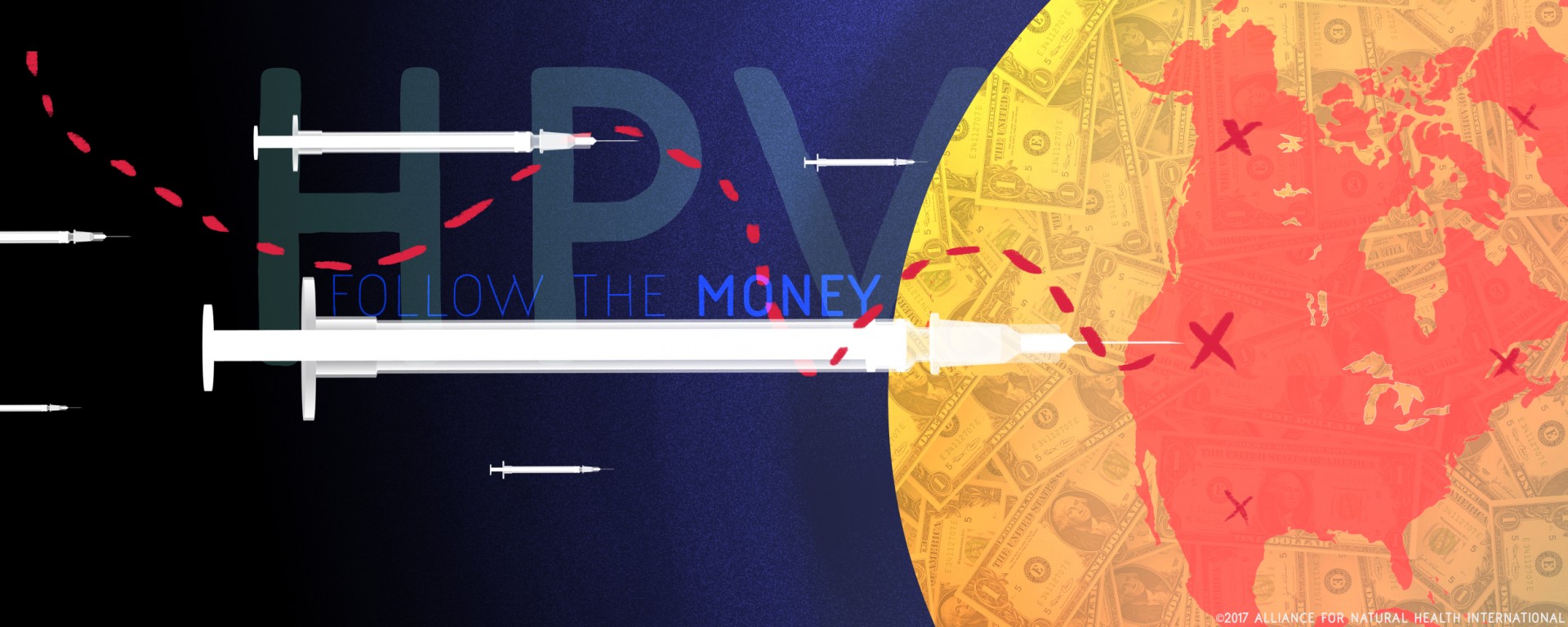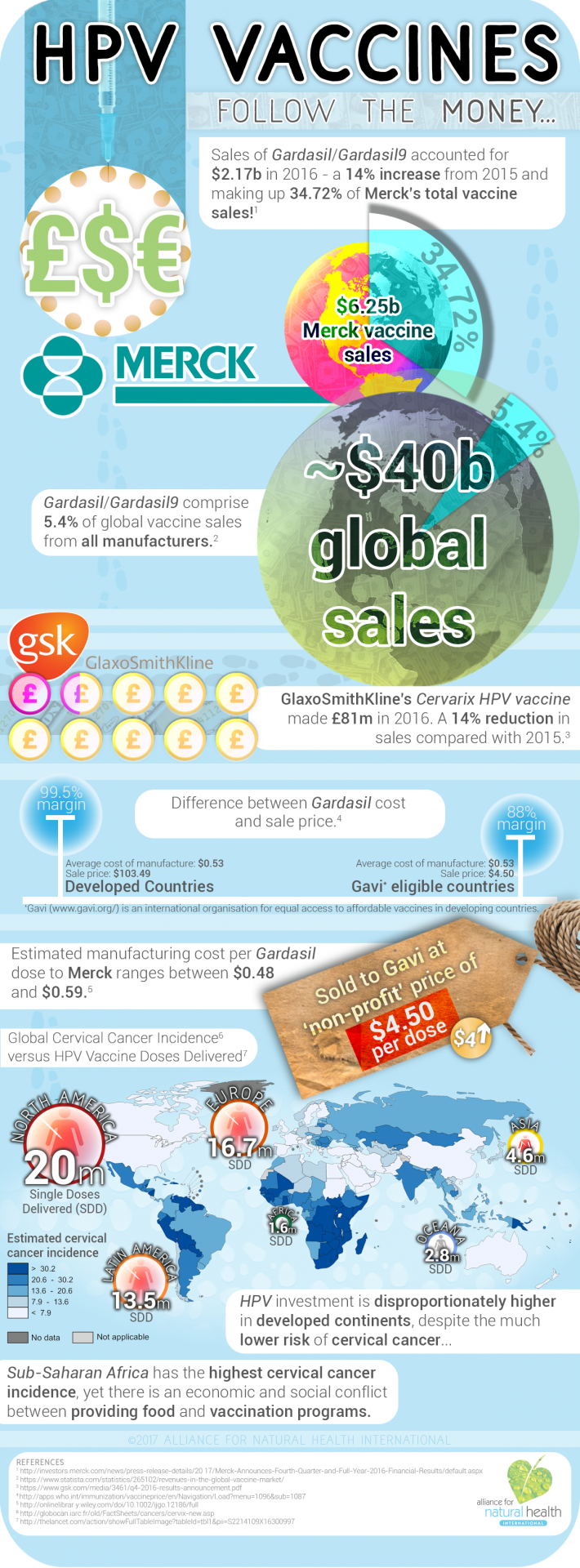Content Sections
Following on from Rob Verkerk’s very personal piece on informed consent and the HPV vaccine last week, we take a look at the money trail around the HPV vaccine. We pose the question: is the driver cervical cancer and other HPV-related diseases – or profit? To answer the question, we’ve looked at some of the economics behind the global HPV vaccination program, with Merck as the producer of Gardasil® being one of the key beneficiaries.
Cervical cancer – the primary target of HPV vaccination of girls – is primarily a problem of the developing world. Yet it’s the affluent industrialised countries, potentially the low hanging fruit for the HPV vaccine manufacturers Merck and GlaxoSmithKline (GSK), that have been the primary markets thus far. In what is often taken as an altruistic move, with cut price deals, attention is now being given to developing countries. This time, it’s not individual governments who are involved, it’s a whole alliance of interests, including governments from industrialised countries, developed countries, the vaccine industry and NGOs like the Bill and Melinda Gates Foundation. They all come together under the banner of Gavi, the vaccine alliance.
Pharma exploitation
Vaccines are currently a $32 billion dollar industry that is projected to grow to $48 billion in 2021. Worldwide sales of Gardasil®, Merck’s controversial HPV vaccine, alone have risen 14% in the year from 2015-2016 from $1.9b to $2.17b. This compares to total global sales for Merck products in 2016 of $40b. Gardasil® is now available in 130 countries with more than 187 million doses being distributed around the world. The average cost of a single dose of Gardasil in developed nations is £103.49. Industrialised nations account for more than half the total vaccine sales worldwide and bear the burden of cost (see infographic).
Through clever marketing, promotion of the vaccine through schools and a lack of information on the potential dangers of the vaccine, girls in the developed world widely accept that the HPV vaccine is their best bet to protect them against cervical cancer. This is despite there being alternative ways of promoting natural immunity, that are not widely promoted.
Click on Infographic to open pdf
1 http://investors.merck.com/news/press-release-details/2017/Merck-Announces-Fourth-Quarter-and-Full-Year-2016-Financial-Results/default.aspx
2 https://www.statista.com/statistics/265102/revenues-in-the-global-vaccine-market/
3 https://www.gsk.com/media/3461/q4-2016-results-announcement.pdf
4 http://apps.who.int/immunization/vaccineprice/en/Navigation/Load?menu=1096&sub=1087
5 http://onlinelibrary.wiley.com/doi/10.1002/ijgo.12186/full
6 http://globocan.iarc.fr/old/FactSheets/cancers/cervix-new.asp
7 http://thelancet.com/action/showFullTableImage?tableId=tbl1&pii=S2214109X16300997
Vaccine vs safe sex education
It’s been estimated that globally 1 in 9 people suffer from lack of food, 1 in 8 in developing regions of sub-saharan Africa and Asia. Most of them are children. With malnutrition comes health issues associated with lowered immunity. Add in the tendency for girls to be married earlier and thus experience sexual intercourse at a much earlier age (a known risk for increased risk of infection with high risk HPV) and the propensity for HPV infection increases along with the prospect of developing cervical cancer.
However, in the day to day struggle to survive, when you often don’t know where your next meal is coming from, just how important is the issue of HPV transmission? What priority is given to the risk of cervical cancer in 20-30 years or genital warts? Is it a justified use of developing nations resources and aid donations from industrialised countries? How much effort is going into improving immunity through changes in nutrition and lifestyle and the education of children and adults on the use of safe sex? Education as a Vaccine is an NGO based in Nigeria promotion safe sex practices to prevent sexually transmitted diseases. Interestingly, before the reliance and relentless promotion of the HPV vaccine as a panacea to the prevention of HPV infection, the WHO was supporting sex education as part of a whole programme to reduce infection rates and thus incidences of cervical cancer.
In 2012 there were 528,000 new cases of cervical cancer worldwide, approximately 85% of which were in less developed regions of the world. Almost nine out of ten of the estimated 266,000 deaths were also in less developed regions. Compare this with HIV infection, which affected 25.6 million people in sub-saharan Africa alone in 2015 and you have to ask whether the focus on HPV is appropriate?
Eyes on the prize!
From whatever angle you look at it, the HPV vaccine is a huge money earner – and this financial benefit is strongly concentrated into just one company, Merck, the manufacturer of Gardasil®, sales of which now dwarf GSK’s Cervarix®. Even given Gavi’s negotiated discount to $4.50 per dose, there’s still a tidy profit to be made given the manufacturing cost of a single dose of HPV vaccine is $0.48 —$0.59 per dose.
Gavi, the vaccine alliance and its partners is the delivery mechanism for HPV vaccines to the developing world. So much so they’ve negotiated a reduced cost (see Infographic) for the HPV vaccine to make it more affordable for developing nations to purchase.
We should also ask ourselves if the money developing and developed nations are committing to vaccination programmes could be better spent elsewhere?
Altruism or Profit
So, what the main drivers? Altruism or profit? Or both? Apparent goodwill is being generated, and a host of charities and other government-controlled mechanisms, from national vaccination programs to Gavi’s initiatives in developing countries are being used. Including boys as a target of national vaccination doubles the global market. The aim appears to be to get as near as possible to 100% of the 9- to 12-year-old population of the world HPV vaccinated.
Interestingly, the UK’s the Joint Committee on Vaccination and Immunisation may have put a spanner in the works. It has just issued an interim advisory that boys should not be included in the vaccination programme due to a lack of cost-effectiveness. One of their justifications given is that boys would be protected anyway because girls are already being vaccinated. Isn’t that discriminatory? Given the safety concerns, isn’t this potentially not just a form of child abuse, but one exclusively singling out the female gender?
Moving back to developing countries, how will adverse events be recorded and reported? How will compensation to vaccine injured victims be worked out? Put simply, these girls will likely have little recourse. In India, scientists came together to call a halt to HPV vaccine trials. Their concerns fell on deaf ears, and the Supreme court in India took up the baton to demand answers after deaths allegedly relating to the Garsasil9® trial were reported.
Get the word out!
Please forward this widely, including to your loved ones, friends and political representatives, ensuring that s/he does more to ensure that information required for properly informed consent is made readily available to parents, guardians and children prior to consent being given.
Please also sign and forward our petition, to Stop health authorities claiming that vaccines are ‘safe’.
Updated 21/07/2017









Comments
your voice counts
19 July 2017 at 10:46 pm
The drug companies are driven by profit and profit only. In the states tens of thousands are killed every year by drugs but they never stop selling them. The HPV vaccine is no different.
20 July 2017 at 7:46 am
Thanks for taking the time to comment Roger.
Warm Regards
Melissa
20 July 2017 at 8:06 am
As Big Pharmas are convicted more than hundreds of times there behaviour equals organised crime
Vaccines and the religion of vaccinism is just a diamond in their portfoliou
There are not good and bad guys in these companies
There are just bad guys and dolls at the boards
They should have been imprisoned long time ago and their business should have been closed
The support from parlamentaries and people that should be supposed to know are perverted
Please read Peter Goetzsche!
Br
Lennart Cedgard MD
21 July 2017 at 8:43 am
Thank you for taking the time to comment Lennart, we appreciate your support.
Warm regards
Melissa
23 July 2017 at 9:05 pm
The vaccine itself is so full of heavy metals those who did not die after the first testing could not even sit up or move off the couch without vomiting! Large number of deaths compared to the total number of test subjects! (Look up HPPV early testing) It's all about population control!
20 July 2017 at 12:27 pm
Vaccines don't work—vaccine MARKETING is what works.
There are literally THOUSANDS of diseases. Yet the only diseases we fear are the ones that a vaccine has been developed and marketed for. We only started fearing measles and mumps in the early 20th century—because the media told us to.
And considering that there are hundreds of thousands of pathogens that we are exposed to each and every day (yet we only vaccinate against 16 of them), thats less than 0.002% of every disease we are exposed to. So statistically—we are essentially all unvaccinated!
Who should we be fearing? THE VACCINATED—because vaccines shed the diseases they were meant to prevent!
"Physicians and public health officials know that recently vaccinated individuals spread disease and that contact with the immunocompromised can be especially dangerous. For example, the Johns Hopkins Patient Guide warns the immunocompromised to "Avoid contact with children who are recently vaccinated," and to "Tell friends and family who are sick, or have recently had a live vaccine (such as chicken pox, measles, rubella, intranasal influenza, polio or smallpox) not to visit."
http://www.cnbc.com/2015/03/03/globe-newswire-public-health-officials-know-recently-vaccinated-individuals-spread-disease.html#
21 July 2017 at 8:43 am
Thanks for your comments Walter. It has been a slow creep, but as you say the marketing has worked extremely well by tapping into our fears!
Warm Regards
Melissa
21 July 2017 at 8:42 am
http://sanevax.org/fda-approved-gardasil-9-malfeasance-or-stupidity/
Your voice counts
We welcome your comments and are very interested in your point of view, but we ask that you keep them relevant to the article, that they be civil and without commercial links. All comments are moderated prior to being published. We reserve the right to edit or not publish comments that we consider abusive or offensive.
There is extra content here from a third party provider. You will be unable to see this content unless you agree to allow Content Cookies. Cookie Preferences